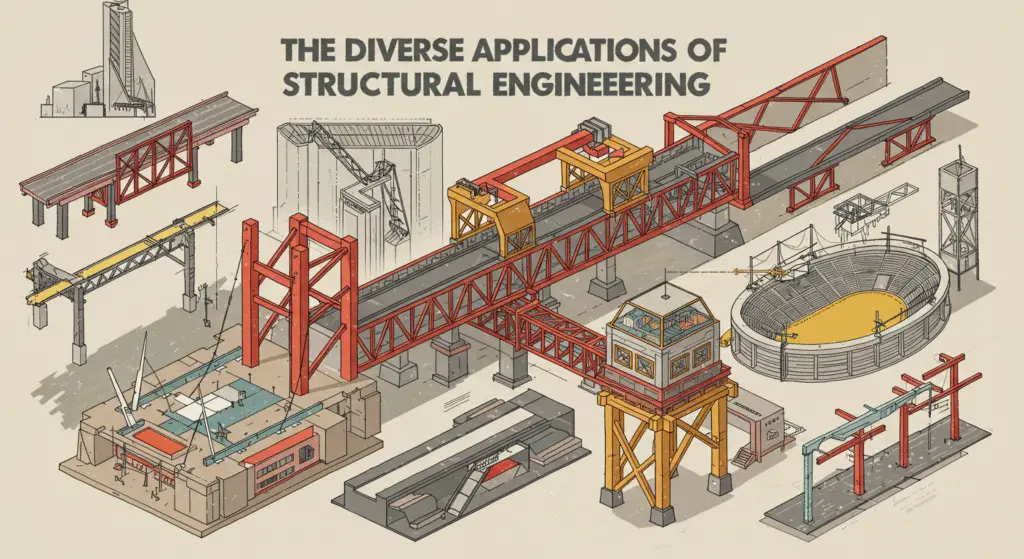What is a structure in engineering?

In the realm of engineering, structures play a fundamental role in the design, construction, and operation of a wide array of systems and products. From the towering skyscrapers that define the skylines of our cities to the intricate frameworks that support the most advanced aerospace technologies, structures are the backbone that enables engineers to transform their innovative ideas into tangible, functional realities.
Structures, in the context of engineering, can be defined as the physical, load-bearing components that provide the necessary support, stability, and integrity to a system or structure. These components, which can range from the beams and columns of a building to the ribs and fuselage of an aircraft, are responsible for withstanding the various forces and stresses that act upon them, ensuring the overall safety, reliability, and performance of the engineered solution.
Understanding the critical role of structures in engineering is essential for both aspiring and practicing professionals, as it forms the foundation for the design, analysis, and optimization of a vast array of engineered systems, from the simplest household items to the most complex infrastructure projects.
The Fundamental Principles of Structural Engineering

At the heart of structural engineering lies a deep understanding of the fundamental principles that govern the behavior of materials and the forces that act upon them. These principles, which are rooted in the fields of physics, mechanics, and materials science, provide the essential framework for the design and analysis of structures, allowing engineers to anticipate and mitigate the various stresses and deformations that can compromise the integrity and performance of their creations.
- Statics and Mechanics of Materials:
- The study of statics and mechanics of materials is crucial for structural engineers, as it enables them to analyze the forces acting on a structure, determine the resulting internal stresses and deformations, and design the necessary components to withstand these forces. This includes understanding concepts such as tension, compression, shear, bending, and torsion, as well as the relationships between loads, stresses, and strains.
- Structural Analysis:
- Structural analysis involves the application of mathematical and computational tools to model and predict the behavior of structures under various loading conditions. This includes the use of analytical methods, such as the finite element method, to simulate the response of structures to static, dynamic, and environmental loads, allowing engineers to optimize the design and ensure the safety and reliability of their creations.
- Materials Science and Engineering:
- The selection and properties of materials play a critical role in the design and performance of structures. Structural engineers must possess a deep understanding of the mechanical, thermal, and chemical characteristics of materials, such as metals, concrete, and composites, to ensure that the chosen materials can withstand the anticipated stresses and environmental conditions throughout the structure’s lifespan.
- Structural Design:
- The art of structural design involves the synthesis of the principles of statics, mechanics of materials, and materials science to create innovative, efficient, and safe structures. This process encompasses the conceptualization of the structural system, the selection of appropriate materials and components, the detailed design of individual elements, and the validation of the overall structural integrity through rigorous analysis and testing.
The Diverse Applications of Structural Engineering

The principles and practices of structural engineering find application across a vast array of industries and domains, from the construction of buildings and bridges to the development of aircraft, spacecraft, and marine vessels. In each of these contexts, the role of structures is paramount, as they provide the essential support, stability, and load-bearing capabilities that enable the safe and reliable operation of these engineered systems.
- Civil and Structural Engineering:
- One of the most prominent applications of structural engineering is in the design and construction of buildings, bridges, and other civil infrastructure. Structural engineers in this field are responsible for ensuring the structural integrity of these large-scale projects, taking into account factors such as gravity loads, wind and seismic forces, and environmental conditions to create safe and functional structures that serve the needs of the community.
- Mechanical Engineering:
- Structural engineering principles are also integral to the design and analysis of mechanical systems, from the frames and chassis of vehicles to the load-bearing components of industrial machinery. Mechanical engineers must consider the structural implications of their designs, accounting for factors such as vibration, fatigue, and impact loads, to ensure the reliability and longevity of their creations.
- Aerospace Engineering:
- In the realm of aerospace engineering, structures play a critical role in the design and performance of aircraft, spacecraft, and their associated systems. Aerospace structural engineers must carefully analyze the complex loading conditions, material properties, and manufacturing processes involved in the creation of these advanced, high-performance systems, ensuring that they can withstand the extreme stresses and environmental conditions encountered during flight.
- Marine Engineering:
- The design and construction of ships, submarines, and offshore structures also rely heavily on the principles of structural engineering. Marine structural engineers must address the unique challenges posed by the marine environment, such as wave loads, hydrostatic pressure, and corrosion, to develop robust and seaworthy vessels and structures that can operate safely and effectively in these harsh conditions.
The Importance of Structures in Engineering
The critical importance of structures in engineering cannot be overstated, as they serve as the foundational elements that enable the realization of a wide range of innovative solutions and technologies. By understanding the fundamental principles of structural engineering and applying them in the design, analysis, and optimization of engineered systems, engineers can ensure the safety, reliability, and performance of their creations, ultimately delivering tangible benefits to society.
- Safety and Reliability:
- The primary function of structures in engineering is to provide the necessary strength, stability, and resilience to withstand the various forces and stresses that act upon them, ensuring the safety and reliability of the overall system. Structural engineers play a crucial role in anticipating and mitigating these risks, designing structures that can protect people, assets, and the environment from potential failures or collapse.
- Functional Performance:
- Structures are not merely passive, load-bearing elements; they also play a vital role in the functional performance of engineered systems. The design and optimization of structural components can directly impact the efficiency, speed, and overall effectiveness of a system, whether it’s the aerodynamic performance of an aircraft, the load-carrying capacity of a crane, or the seismic resilience of a building.
- Cost-Effectiveness and Sustainability:
- Effective structural design can also contribute to the cost-effectiveness and sustainability of engineered solutions. By optimizing the use of materials, minimizing waste, and maximizing the efficiency of load transfer, structural engineers can help reduce the overall costs and environmental impact associated with the construction, operation, and maintenance of engineered systems.
- Aesthetic and Architectural Expression:
- In addition to their functional roles, structures can also serve as powerful expressions of architectural and aesthetic design. The iconic structures that define the skylines of our cities, from soaring skyscrapers to graceful bridges, demonstrate how the principles of structural engineering can be harmoniously integrated with the creative vision of designers and architects to create structures that are both technically sound and visually captivating.
Embracing the Challenges of Structural Engineering
As the world continues to face complex challenges, from the need for resilient infrastructure to the development of innovative, high-performance technologies, the role of structural engineering will only become more critical in the years to come. Aspiring and practicing engineers must embrace the inherent complexities and challenges of this discipline, constantly pushing the boundaries of what is possible through the application of their technical expertise, creative problem-solving skills, and commitment to the safety and well-being of society.
Some of the key challenges and emerging trends in structural engineering include:
- Adapting to Changing Environmental Conditions:
- As the effects of climate change become more pronounced, structural engineers must develop innovative solutions that can withstand the increasingly severe weather patterns, natural disasters, and environmental stresses that threaten the integrity of engineered systems.
- Incorporating Advanced Materials and Technologies:
- The rapid advancements in materials science and computational tools are transforming the field of structural engineering, enabling the design and construction of structures that are lighter, stronger, and more efficient than ever before. Embracing these innovations is crucial for engineers to stay at the forefront of their profession.
- Addressing Societal and Sustainability Concerns:
- The engineering profession is increasingly being called upon to address the broader social and environmental impacts of its work. Structural engineers must integrate principles of sustainability, equity, and ethical decision-making into their designs, ensuring that their creations not only meet the technical requirements but also serve the greater good of the communities they serve.
- Fostering Interdisciplinary Collaboration:
- As the challenges facing the world become more complex, structural engineers must work closely with professionals from other disciplines, such as architects, urban planners, and environmental scientists, to develop holistic, integrated solutions that address the multifaceted needs of modern society.
By embracing these challenges and continuously expanding their knowledge and skills, structural engineers can play a pivotal role in shaping a more sustainable, resilient, and equitable future for all. Through their unwavering commitment to the principles of structural engineering and their ability to translate these principles into tangible, real-world solutions, these professionals will remain at the forefront of the engineering field, driving progress and innovation for generations to come.

Pingback: Is structural engineering a good career? – worldcivilsociety.com
Pingback: What are the 5 stages of structural design?, How to structural design works - worldcivilsociety.com
Pingback: How to Weigh The advantages and disadvantages in Structural Engineering